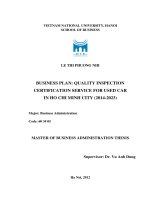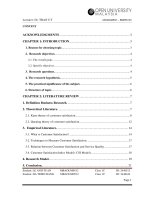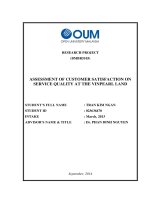Measuring customer satisfaction towards service quality of the maternity hospital in ho chi minh city
Bạn đang xem bản rút gọn của tài liệu. Xem và tải ngay bản đầy đủ của tài liệu tại đây (1021.61 KB, 81 trang )
MEASURING CUSTOMER SATISFACTION TOWARDS SERVICE QUALITY OF
THE MATERNITY HOSPITAL IN HO CHI MINH CITY
In Partial Fulfillment of the Requirements of the Degree of
MASTER OF BUSINESS ADMINISTRATION
In Marketing
by
Ms: NGUYEN THI THANH BINH
ID: MBA03004
International University - Vietnam National University HCMC
January 2013
MEASURING CUSTOMER SATISFACTION TOWARDS SERVICE QUALITY OF
THE MATERNITY HOSPITAL IN HO CHI MINH CITY
In Partial Fulfillment of the Requirements of the Degree of
MASTER OF BUSINESS ADMINISTRATION
In Marketing
by
MS: NGUYEN THI THANH BINH
ID: MBA03004
International University - Vietnam National University HCMC
January 2013
Under the guidance and approval of the committee, and approved by all its members, this
thesis has been accepted in partial fulfillment of the requirements for the degree.
Approved:
---------------------------------------------Chairperson
--------------------------------------------Committee member
---------------------------------------------Committee member
--------------------------------------------Committee member
---------------------------------------------Committee member
--------------------------------------------Committee member
Acknowledge
Firstly, I especially want to thank my advisor, Doctor Nguyen Van Phuong,
for his guidance during my research. His perpetual energy and enthusiasm in
research had motivated all his advisees, including me. In addition, he was always
accessible and willing to help his students with their research.
I am myself showing my deepest thanks to Dr Ho Thanh Phong – Rector and
Dr. Nguyen Quynh Mai – Dean and all of colleagues, friends and my classmates of
MBA10 who support and create advantageous conditions for me to study and
complete this thesis.
Finally yet importantly, I would like to give my special thanks to my family
whose patient love enabled me to finish this work.
Ho Chi Minh /January 2013.
Nguyen Thi Thanh Binh
i
Plagiarism Statements
I would like to declare that, apart from the acknowledged references, this
thesis either does not use language, ideas, or other original material from anyone; or
has not previously submitted to any other educational and research programs or
institutions. I fully understand that any writings in this thesis contradicted to the
above statement will automatically lead to the rejection from the MBA program at
the International University – Vietnam National University Ho Chi Minh City.
ii
Copyright Statement
This copy of the thesis has supplied on condition that anyone who consults it
understood to recognize that its copyright rests with its author and that no quotation
from the thesis and no information derived from it may publish without the author’s
prior consent.
© Nguyen Thi Thanh Binh/ MBA03004/2010-2012
iii
Table of Contents
Chapter one – Introduction....................................................................................... 1
1. Introduction .......................................................................................................... 1
2. Research Problems ............................................................................................... 2
3. Research Objectives ............................................................................................. 2
4. Scope .................................................................................................................... 2
5. Implication of research ........................................................................................ 3
6. Research structure ............................................................................................... 3
Chapter Two – Literature Review............................................................................ 5
1. Definition of Service ............................................................................................ 5
2. Features of services .............................................................................................. 5
3. Service Quality..................................................................................................... 6
4. Service-quality model .......................................................................................... 7
5. Customer Satisfaction ........................................................................................ 11
6. The relationship between service quality and customer satisfaction ................. 12
7. Some empirical findings on service quality in maternity hospital ..................... 13
7.1. Dimensions of service quality ..................................................................... 15
7.2 Customer satisfaction with service quality of the maternity hospital ......... 15
8. Research Model ................................................................................................. 16
Chapter Three – Research Method ........................................................................ 19
1. The introduction about the maternity hospitals in Ho Chi Minh City. .............. 19
1.1 Tu Du hospital
19
1.2 Sai Gon International hospital
19
1.3 Hung Vuong hospital
20
1.4 University Medical Center hospital
20
iv
2. Scale ................................................................................................................... 21
2.1. Service Quality Scale. ............................................................................. 21
2.2 Scale of customer satisfaction. ................................................................. 23
3. Research Procedure ............................................................................................ 24
4. Sample Size ........................................................................................................ 25
5. Questionnaire Design ......................................................................................... 25
6. Analysis techniques ........................................................................................... 27
6.1. Descriptive Statistics ................................................................................... 27
6.2. Testing reliability of scale by Cronbach’s Alpha ....................................... 27
6.3. Exploratory Factors Analysis (EFA) .......................................................... 28
6.4. Multiple-Regression Analysis ..................................................................... 28
Chapter Four - Main Findings................................................................................ 29
1. Sample Description ........................................................................................... 29
1.1 Age description
29
1.2 Career description
30
1.3 Income description
30
2. Descriptive Statistics of KQCAH scale. ........................................................... 31
3. Assessment and Refinement of Scale. .............................................................. 35
3.1. Testing the reliability of service quality scale by Cronbach’s alpha .......... 36
3.2. Testing the reliability of customer satisfaction scale by Cronbach’s alpha. ........... 38
3.3. Assessment on Service Quality Scale using EFA analysis ......................... 43
3.4. Assessment of Customer Satisfaction Scale through EFA analysis ........... 43
3.5. Research Model Adjustment ....................................................................... 44
3.6. Testing the research model using ................................................................ 45
v
3.6.1. Correlation Matrix: .............................................................................. 46
3.6.2. Regression Analysis ............................................................................. 47
3.7. Comparison of customer satisfaction level between the maternity hospitals ....... 48
3.8. Discussion of results ................................................................................... 52
Chapter Five – Conclusion and Recommendation ............................................... 54
1. Conclusion ......................................................................................................... 54
2. Recommendations .............................................................................................. 54
3. Research Limitations ......................................................................................... 56
vi
List of Tables
Table 1: Dimensions quality ...................................................................................... 14
Table 2: Factors in study ........................................................................................... 18
Table 3: Coding variables in measurement scale ...................................................... 25
Table 4: Descriptive Statistics of Human and physical resources ............................. 31
Table 5: Descriptive Statistics of Efficiency and Continuty....................................... 32
Table 6: Descriptive Statistics of Facilities ............................................................... 33
Table 7: Descriptive Statistics of Information ........................................................... 33
Table 8: Descriptive Statistics of The hospital charges ............................................. 34
Table 9: Descriptive Statistics of First impression .................................................... 34
Table 10: Descriptive Statistics of Customer Satisfaction ......................................... 35
Table 11: Cronbach’s Alpha analysis of KQCAH scale ............................................ 38
Table 12: Cronbach’s Alpha analysis of customer satisfaction................................. 39
Table 13: Frequency of customer satisfaction .......................................................... 39
Table 14: KMO and Bartlett’s test about service quality ......................................... 40
Table 15: Rotated Component Matrixa ..................................................................... 42
Table 16: Total variance explained ........................................................................... 43
Table 17: Cronbach’s Alpha analysis of factors........................................................ 43
Table 18: Component matrix of customer satisfaction ............................................. 44
Table 19: KMO and Bartlett’s of customer satisfaction ............................................ 44
Table 20: KMO and Bartlett’s of new factors ............................................................ 46
Table 21: Model summary ......................................................................................... 46
Table 22: Coefficients ................................................................................................ 47
Table 23: Anova ......................................................................................................... 48
vii
List of Figures
Figure 1: Research Model .......................................................................................... 16
Figure 2: Adjusted Research Model ........................................................................... 17
Figure 3: Research process ........................................................................................ 24
Figure 4: Age description ........................................................................................... 29
Figure 5: Career description ...................................................................................... 30
Figure 6: Income description ..................................................................................... 30
Figure 7: Frequency of customer satisfaction ............................................................ 33
Figure 8: Adjusted research model after EFA analysis ............................................. 39
Figure 9: Comparison customer satisfaction level between the maternity hospitals . 44
Figure 10: Introduction of customers ......................................................................... 47
viii
Abbreviation
EFA: Exploratory Factors Analysis
KQCAH: The Key Quality Characteristics Assessment for Hospitals
KMO: Kaiser-Meyer-Olkin
JCAHO: Joint Commission on Accreditation of Healthcare Organizations
SERVQUAL: Service quality
SPSS: Statistical Package for Social Sciences
ix
Abstract
Service quality of the maternity hospital is been perceived as an important
factor for customer satisfaction. The aim of this study is to analyze the customer
satisfaction about service quality of the maternity hospital. Besides, it is to determine
the hospital service quality from the pregnant women’s viewpoints and the relative
importance of quality dimensions to improve better service quality for pregnant
women and babies. This study was been conducted with 225 respondents who are
pregnant women or women giving birth within 6 months in the maternity hospitals in
Ho Chi Minh City in 2012. As a result, there are five (05) factors of service quality in
the maternity hospitals impacting on customer satisfaction. Those are effectiveness
and continuity; human and physical resources; the hospital charges; facilities and
information. This research provides a framework to researchers know. The result
may help the maternity hospitals to improve better service quality.
Keywords: Customer satisfaction, service quality, maternity hospital,
pregnant women.
x
xi
Chapter one – Introduction
1. Introduction
The hospital industry is one of the fastest growing industries today. Hospital
managers have to understand the quality and the value of services offering to their
consumers. The positive consequences of companies achieving high levels of
customer satisfaction and service quality are well-documented (Rust & Zahorik,
1993; Zeithaml, Berry and Parasuraman, 1996). Indeed, service quality and customer
satisfaction issues are very important as companies attempt to differentiate their
services and compete effectively in the marketplace (Parasuraman, Zeithaml & Berry
[PZB}, 1988; Brown & Swartz, 1989).
A hospital is an institution of health care providing treatment with specialized
staff and equipment, but not always providing for long-term patient stay. Today
hospitals are centers of professional health care provided by physicians and nurses.
The state, health organizations, health insurances or charities, including direct
charitable donations usually provide financial support and other assistance to
hospitals. There are several kinds of hospitals. Types of specialized hospitals include
trauma centers, rehabilitation hospitals, children’s hospitals, seniors' (geriatric)
hospitals, maternity hospitals and hospitals for dealing with specific medical needs
such as psychiatric problems (see psychiatric hospital), certain disease categories
such as cardiac, oncology, or orthopedic problems, and so forth. Moreover, the
hospitals are been developed in Vietnam. However, the author wants to focus the
maternity hospital in Ho Chi Minh City because the author is a pregnant woman. The
author also wants to know service quality of the maternity hospital in Ho Chi Minh
City to choose hospital for giving birth next year. Therefore, the author wants to
measure customer satisfaction and evaluates the service quality of the maternity
1
hospitals in Ho Chi Minh City. In addition, implications about study for the
maternity hospitals to improve better service quality for pregnant women or women
give birth whom will come in there.
2. Research problems
Much of study and literature in marketing and management recognizes the
importance of customer satisfaction. Therefore, it would be quite natural that such
services would have an impact on the customer satisfaction. In this study, the author
wants to focus service quality of the maternity hospitals. What do pregnant women
want to have service quality of the maternity hospital in Ho Chi Minh City? How did
the maternity hospitals take care for women giving birth? What do pregnant women
expect service quality of the maternity hospitals?
That is the reason for the author to choose this research topic: “MEASURING
CUSTOMER SATISFACTION TOWARDS SERVICE QUALITY OF THE
MATERNITY HOSPITALS IN HO CHI MINH CITY”
3. Research objective
Identify determinants of service quality of the maternity hospital in
Ho Chi Minh City area.
Identify customer satisfaction towards service quality
Recommend some solutions for maternity hospitals to improve better
service quality for pregnant women.
4. Scope
The scope of present research includes measuring the quality services and
evaluating customer satisfactions for the pregnant women or women gave birth
within 6 months in the maternity hospital in Ho Chi Minh City. The total duration
time for implementing this study is about 05 months (from August 2012 to January
2
2013); the data collection was been conducted in the maternity hospitals in Ho Chi
Minh City area.
5. Implication of research
Measuring the service quality and evaluating customer satisfactions for the
pregnant women or women gave birth within 6 months in the maternity hospital in
Ho Chi Minh City. Continuing to correct maternity hospitals to improve level of
better quality services and caring for pregnant women and babies.
6. Research structure
The structure of the thesis consist five chapters:
Chapter 01: Introduction
Chapter 1 introduces about service quality of the maternity hospital industry
in Ho Chi Minh City. This part will include the reasons of this research and some
existing problems need to have optimal solutions to solve.
Chapter 02: Literature Review
This chapter addresses the theories of service quality, customer satisfaction,
factors that affect customer satisfaction.
Chapter 03: Research model
In this chapter, the report will describe in detail the methods and research
design including data collection method, population approach. Besides, the
measurement scale used in proposed model should be included as well.
Chapter 04: Main Findings
The previous chapter presented the research methodology. Following, this
chapter will describe the characteristics of the sample, present the data analysis and
discuss the findings of the research.
3
Chapter 05: Conclusions & Recommendations
-
Conclusion: Main results of this study.
-
Recommendations for maternity hospital to improve better service quality
-
Research Limitations
4
Chapter Two – Literature Review
1. Definition of Service
Kotler and Keller (2010) define service as follows:
“A service is any act or performance one party can offer to another that is
essentially intangible and does not result in the ownership of anything” (page 386.)
2. Features of services
Services have distinctive characteristics compared to common goods,
includes intangibility, inseparability, variability and perishability (Kotler and Keller,
2010).
- Intangibility: Services are intangible means that they cannot be touched,
gripped, handled, looked at, smelled, tasted or heard. Thus, there is neither potential
nor need for transport, storage or stocking of services. Furthermore, a service cannot
be (re)sold or owned by somebody, neither can it be turned over from the service
provider to the service consumer nor returned from the service consumer to the
service provider. Solely, the service delivery can commissioned to a service provider
who must generate and render the service at the distinct request of an authorized
service consumer.
- Inseparability: The service provider is indispensable for service delivery as
he must promptly generate and render the service to the requesting service consumer.
In many cases, the service delivery executed automatically but the service provider
must preparatory assign resources and systems and actively keeps up appropriate
service delivery readiness and capabilities. Additionally, the service consumer is
inseparable from service delivery because he is involved in it from requesting it up to
consuming the rendered benefits.
5
- Variability: Each service is unique. It is one-time generated, rendered and
consumed and can never be exactly repeated as the point in time, location,
circumstances, conditions, current configurations and/or assigned resources are
different for the next delivery, even if the same service consumer requests the same
service. Many services are been regarded as heterogeneous or lacking homogeneity
and are typically modified for each service consumer or each new situation.
-
Perishability: Services cannot be stored and available at the time when it
was been provided. Perishability can be a problem if the demand fluctuates.
Each of these characteristics is retractable per se and their inevitable
coincidence complicates the consistent service conception and makes service
delivery a challenge in each case. Proper service marketing requires creative
visualization to evoke effectively a concrete image in the service consumer's mind.
From the service consumer's point of view, these characteristics make it difficult, or
even impossible, to evaluate or compare services prior to experiencing the service
delivery.
3. Service Quality
Managing the quality of service is an interesting subject in Marketing. Until
now, there have been many studies related to this topic, therefore, also have its
definitions were given. However, no agreements are been made. From the standpoint
of customers, the quality of service means a measure how well a delivered service
matches customers’ expectation and satisfies their requirements (Lewis and Booms,
1983).
Quality is one of important elements to service and physical goods, and
criteria for consumers in distinguishing and selecting the provider among many
competitors. For service industry, quality cannot estimate before. Therefore, it has
6
caused difficulty for both assessment of customers (in purchasing process) and
providers (in after sales service.).
4. Service-quality model
According to Gronroos (1984), the service quality experienced by a customer
has two dimensions: Technical and Functional quality. In which Functional quality
describes how the service is to deliver and technical quality describes what the
customers received during a service delivery. The organization’s image works as a
filter and can modify positively or negatively the customers’ perception of service
quality. Gronroos (2007) emphasizes that the followings “Seven criteria of good
perceived service quality” are the determinants that need to be considered when
evaluating the service quality of any organization: professionalism and skills;
attitudes and behavior; accessibility and flexibility; reliability and trustworthiness;
service recovery; service scale; reputation and credibility.
However, the above Seven criteria of good perceived service quality”,
concepts have the similar characteristics to the Parasuraman el at (1985) “Ten
determinants of service quality”.
Based on this service-quality model, Parasuraman et. al., (1988)
developed SERVQUAL (Service Quality) scale. This is a multi-item scale
developed to assess customer perceptions of service quality in service and retail
businesses (Parasuraman et. al., 1988). Parasuraman, in his initial paper,
introduced the gaps model and established ten possible determinants of service
quality (Parasuraman, 1985). Include:
1.
Competence (Possession of the required skills and knowledge to perform the
service: knowledge and skill of the contact personnel, knowledge and skill of
the operational support personnel, research capability of the organization)
7
2.
Courtesy (Politeness, respect, consideration and friendliness of the contact
personnel: consideration for the customer's property, clean and neat
appearance of public contact personnel)
3.
Credibility (Trustworthiness, believability and honesty. It involves having
the customer's best interest at heart: company name, company reputation,
personal characteristics of the contact personnel)
4.
Security (Freedom from danger, risk or doubt: physical safety, financial
security, confidentiality)
5.
Access (Approachability and ease of contact: Service is easily accessible,
waiting time to receive service is not extensive, convenient hours of
operation, convenient location of service facility)
6.
Communication (Informing the customers in a language they can understand
and listening to them. It may mean that the company has to adjust its
language for different consumers: explaining the service itself, explaining
how much the service will cost, explaining the trade-offs between service and
cost, assuring the consumer that the problem will be handled)
7.
Understanding/ knowing the customer (Making the effort to understand the
customer's needs: understanding customer's specific needs, providing
individualized attention, recognizing the customer)
8.
Tangibles (Physical evidence of the service: appearance of physical facilities,
tools and equipments used to provide the service, appearance of personnel
and communication materials, other customers in the service facility)
9.
Reliability (The ability to perform the promised service dependably and
accurately: service is performed right at the first time, the company keeps its
8
promises in accuracy in billing, in keeping records correctly and in
performing the services at the designated time)
10. Responsiveness (The willingness and/ or readiness of employees to help
customers and to provide prompt service, timeliness of service: mailing a
transaction slip immediately, setting up appointments quickly)
The advantage of these models is able to cover all attributes of service.
However, its weakness is that measurement is very complicated. Therefore, Victor
Sower, JoAnn Duff, William Kilbourne, Gerald Kohers and Phyllis Jones (2001)
developed KQCAH scale (The Key Quality Characteristics Assessment for
Hospitals) and based on theoretical framework of the quality hospital service’s
JCAHO (Joint Commission on Accreditation of Healthcare Organizations) to
measure hospital quality. The authors asserted that nine components of JCAHO are
similar with the components of SERVQUAL and it is easier to understand. That the
components of JCAHO completed SERVQUAL tools and chosen as the theoretical
framework on the hospital quality.
Using a combination of qualitative and quantitative research mythologies,
Victor Sower, JoAnn Duff, William Kilbourne, Gerald Kohers and Phyllis Jones
(2001) defined the components of hospital service quality and developed an
instrument to measure patient satisfaction. The authors formed eight components to
measure the quality of hospital services. Those are: (1) Respect and caring, (2)
Effectiveness and continuity, (3) Appropriateness, (4) Information, (5) Efficiency,
(6) Meals, (7) First impression, (8) Staff diversity.
-
Respect and caring: “with which services are provided. The degree to
which the pregnant women/ women gave birth within 6 months or a
9
designee is involved in her-own care decisions and to which these
providing services do so with sensitivity and respect for the pregnant
women’s need, expectations, and women gave birth within 6 months
differences.
-
Effectiveness: “with which tests, procedures, treatments and services are
provided. The degree to which the care provided in the correct manner,
given the current state of knowledge, to achieve the desired or projected
outcome for the pregnant women or women gave birth within 6 months.
-
Continuity: “of the services provided to the pregnant women with respect
to other services, practitioners, and providers and over time. The degree to
which the care for the pregnant women are coordinated among
practitioners, among organizations, and overtime”
-
Appropriateness: “of a specific test, procedure or service to meet the
pregnant women’s needs. The degree to which the care provided is
relevant to the pregnant women’s clinical needs, given the current state of
knowledge”
-
Efficiency: ‘with which services are provided. The relationship between
the outcomes (results of care) and the re-sources used to deliver pregnant
women care”
-
Information: to help and contact with patients and the patient’s family.
For examples: to provide quick information on the treatment, doctors and
consultants that are available.
-
Meals: quality and efficiency of the supply of food such as taste food for
pregnant women, on time and eat the hot food
10
-
First impression: the reputation of the hospital; provide fast service;
dedication and enthusiasm of the doctors and nurses in hospitals; beautiful
design; clean; fully equipped for mothers and babies.
-
Staffs diversity: includes the variety of facial expressions, gender, they
can speak many languages.
Therefore, KQCAH has eight components to measure the quality of hospital
services. KQCAH is a multi-item scale that can provide valid and reliable
information to hospital administrators. A hospital company with multiple units will
find KQCAH that a useful way to compare the quality among its own units. So,
KQCAH scale selected for theoretical framework for this study.
5. Customer Satisfaction
There is general agreement that: Satisfaction is a person’s feeling of pleasure
or disappointment resulting from comparing a product’s perceived performance (or
outcome) in relation to his or her expectations (Kotler, 2003). Based on this review,
customer satisfaction is been defined as the result of a cognitive and affective
evaluation, where some comparison standard is compared to the actually perceived
performance. If the perceived performance is less than expected, customers will be
dissatisfied. On the other hand, if the perceived performance exceeds expectations,
customers will be satisfied. Otherwise, if the perceived expectations are been met
with performance, customers are in an indifferent or neutral stage.
Customer satisfaction is been defined as a customer’s overall evaluation of
the performance of an offering to date. This overall satisfaction has a strong positive
effect on customer loyalty intentions across a wide range of product and service
categories (Gustafson, 2005).
11
It is been seen as a key performance indicator within business. In a
competitive marketplace where businesses compete for customers, customer
satisfaction is been considered as a key differentiator and increasingly has become a
key element of business strategy.
6. The relationship between service quality and customer satisfaction
Service quality and customer satisfaction are important concepts to academic
researchers studying consumer and customer loyalty (Dawn, Amy & Kent, 1995).
There has had research on service and generally, service quality and customer
satisfaction are distinct definitions (Bitner, 1990; Boulding & et. al., 1993).
The satisfaction of customer, is an overall concept, states their satisfaction
when they buy service. While service quality is considered by service dimensions
(Zeithaml & Bitner, 2000).
According to Oliver (1993), service quality has affected to customer
satisfaction. It shows that service quality, defined by many different factors, is a
determinant of satisfaction.
7. Some empirical findings on service quality in maternity hospital
7.1. Dimensions of service quality
Naresh K. et al. (2004) identified the antecedents of what the international
consumer perceives as service “quality.” This paper aims to examine the differences
in perception of service quality dimensions between developed and developing
economies. Parasuraman et al. (1985) proposed a framework consisting of ten
determinants or dimensions of service quality: reliability, access, and understanding
of the customer, responsiveness, competence, courtesy, communication, credibility,
security, and tangible considerations.
12









